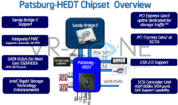Monday, May 2nd 2011

Computex 2011 Launchpad for Intel X79 Motherboards
At Computex 2010, motherboard vendors across the board displayed socket LGA1155 motherboards that support Intel "Sandy Bridge" processors, based on P67, H67 chipsets, months in advance of the platform actually making it to the market. This year, the motherboard industry will do something similar and show off socket LGA2011 motherboards based on the Intel X79 "Patsburg" chipset.
Detailed to much length in older articles, the platform schematic of Sandy Bridge-E surfaced, confirming X79's feature-set, including a PCI-Express 3.0 based supplementary interconnect between the processor and chipset to bolster enough bandwidth for the massive 10-port SATA 6 Gb/s controller, and a 8-port PCI-Express 2.0 hub. Sandy Bridge-E processor itself comes in three main variants, an all-enabled 6-core Extreme Edition, a 6-core unlocked variant, and a limited-OC 4-core variant. The platform is slated for late 2011.
Source:
VR-Zone
Detailed to much length in older articles, the platform schematic of Sandy Bridge-E surfaced, confirming X79's feature-set, including a PCI-Express 3.0 based supplementary interconnect between the processor and chipset to bolster enough bandwidth for the massive 10-port SATA 6 Gb/s controller, and a 8-port PCI-Express 2.0 hub. Sandy Bridge-E processor itself comes in three main variants, an all-enabled 6-core Extreme Edition, a 6-core unlocked variant, and a limited-OC 4-core variant. The platform is slated for late 2011.

25 Comments on Computex 2011 Launchpad for Intel X79 Motherboards
Intel wants USB dead.....
If there are no USB ports on the motherboard, it will be a bad day for inter-connectivity.
As the very first gen NEC USB3 chips were presented :)
@btarunr
I just noticed it, and would be better from software side, because Intel driver usually great!
I know, that is no speed difference between 3rd party and built in controllers.
Panther Point has a 2-port USB 3.0 controller that is multiplexed between two hubs of the USB 2.0 controller to give four USB 3.0 ports. Speeds will suck, if there are more than two bandwidth-heavy devices connected.
On the other hand, using a number of 2-port controllers ends up being bandwidth-efficient, and those NEC/Renesas 2-port controllers have become dirt-cheap after getting competition from ASUS (ASMedia).Yup.Intel's USB 2.0 controller "driver" isn't much more than OHCI driver with name strings for the controllers.
I'm sure the USB3 bridge companies aren't complaining :p
I don't see much usage for USB3 at the current point in time for any of my needs,
I'd rather hot swap a faster, slightly larger, 2.5" SATA2 SSD drive than fumble around with the (fat) USB3 PEZ-dispensers.
The USB3 UFD (circuit/bridge) designs I've seen are all pretty lame too.
Only difference i have noticed is that windows boots a extra app.
Has anyone considered that this is not the full feature list ?
Also AMD please keep making slow chips and horrible drivers for your video cards I want you to continue to crash and burn LOL.
To the end-user where those USB 3.0 ports are coming from doesn't matter. If it's integrated with the PCH, its cost is factored into chipset cost, and if not, 3rd party controllers/hub chips.
A new socket every year?!